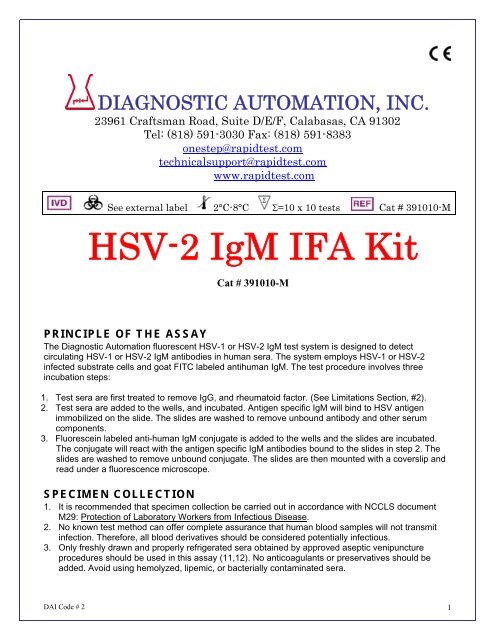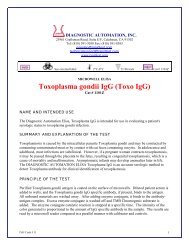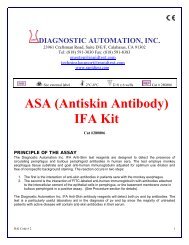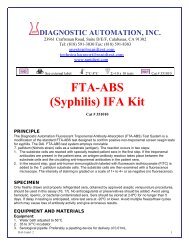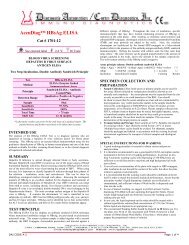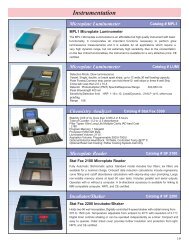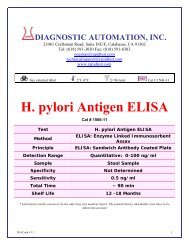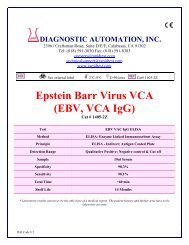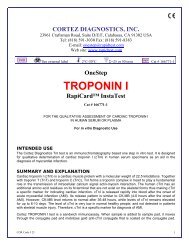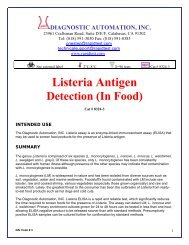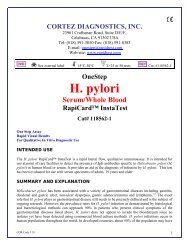HSV-2 IgM IFA Kit - ELISA kits - Rapid tests
HSV-2 IgM IFA Kit - ELISA kits - Rapid tests
HSV-2 IgM IFA Kit - ELISA kits - Rapid tests
You also want an ePaper? Increase the reach of your titles
YUMPU automatically turns print PDFs into web optimized ePapers that Google loves.
DIAGNOSTIC AUTOMATION, INC.23961 Craftsman Road, Suite D/E/F, Calabasas, CA 91302Tel: (818) 591-3030 Fax: (818) 591-8383onestep@rapidtest.comtechnicalsupport@rapidtest.comwww.rapidtest.comSee external label 2°C-8°C Σ=10 x 10 <strong>tests</strong> Cat # 391010-M<strong>HSV</strong>-2 <strong>IgM</strong> <strong>IFA</strong> <strong>Kit</strong>Cat # 391010-MPRINCIPLE OF THE ASSAYThe Diagnostic Automation fluorescent <strong>HSV</strong>-1 or <strong>HSV</strong>-2 <strong>IgM</strong> test system is designed to detectcirculating <strong>HSV</strong>-1 or <strong>HSV</strong>-2 <strong>IgM</strong> antibodies in human sera. The system employs <strong>HSV</strong>-1 or <strong>HSV</strong>-2infected substrate cells and goat FITC labeled antihuman <strong>IgM</strong>. The test procedure involves threeincubation steps:1. Test sera are first treated to remove IgG, and rheumatoid factor. (See Limitations Section, #2).2. Test sera are added to the wells, and incubated. Antigen specific <strong>IgM</strong> will bind to <strong>HSV</strong> antigenimmobilized on the slide. The slides are washed to remove unbound antibody and other serumcomponents.3. Fluorescein labeled anti-human <strong>IgM</strong> conjugate is added to the wells and the slides are incubated.The conjugate will react with the antigen specific <strong>IgM</strong> antibodies bound to the slides in step 2. Theslides are washed to remove unbound conjugate. The slides are then mounted with a coverslip andread under a fluorescence microscope.SPECIMEN COLLECTION1. It is recommended that specimen collection be carried out in accordance with NCCLS documentM29: Protection of Laboratory Workers from Infectious Disease.2. No known test method can offer complete assurance that human blood samples will not transmitinfection. Therefore, all blood derivatives should be considered potentially infectious.3. Only freshly drawn and properly refrigerated sera obtained by approved aseptic venipunctureprocedures should be used in this assay (11,12). No anticoagulants or preservatives should beadded. Avoid using hemolyzed, lipemic, or bacterially contaminated sera.DAI Code # 2 1
4. Store sample at room temperature for no longer than 8 hours. If testing is not performed within 8hours, sera may be stored between 2° and 8°C for no longer than 48 hours. If delay in testing isanticipated, store test sera at –20°C or lower. Avoid multiple freeze/thaw cycles that may cause lossof antibody activity and give erroneous results.EQUIPMENT AND MATERIALSMATERIALS REQUIRED BUT NOT PROVIDED:1. Small serological, Pasteur, capillary, or automatic pipettes.2. Small test tubes, 13 x 100 mm or comparable.3. Test tube racks.4. Staining dish - A large staining dish with a small magnetic mixing set-up provides an idealmechanism for washing slides between incubation steps.5. Cover slips: 24 x 60mm, thickness No. 1.6. Distilled water.7. Moist 37°C incubation chamber.8. IgG removal system (See Limitations, #2).9. Properly equipped fluorescent microscope assembly.The following filter systems or their equivalent have been found to be satisfactory for routine use withtransmitted or incident lightdarkfield assemblies.TRANSMITTED LIGHTLight Source: Mercury vapor 200W or 50WExcitation Filter Barrier Filter Red Suppression FilterKP490 K510 or K530 BG38BG12 K510 or K530 BG38FITC K520 BG38Light Source: Tungsten – Halogen 100WKP490 K510 or K530 BG38INCIDENT LIGHTLight Source: Mercury Vapor 200, 100, 50 WExcitation Filter DichroicMirrorBarrierFilterRed SuppressionFilterKP500 TK510 K510 orBG38K530FITC TK510 K530 BG38Light Source: Tungsten – Halogen 50 and 100 WKP500 TK510 K510 orBG38K530FITC TK510 K530 BG38MATERIALS PROVIDEDReactive Reagents:1. <strong>HSV</strong>-1 or <strong>HSV</strong>-2 Antigen Slides: Ten, 10-well substrate slides containing infected and uninfectedcells in each well. (Product No:381010-M, <strong>HSV</strong>-1) or (Product No:391010-M, <strong>HSV</strong>-2).2. Goat anti-human <strong>IgM</strong> (µ chain specific) labeled with FITC: Contains 1.25% Bovine Albumin andcounter stain. Two, 1.5mL vials, lyophilized. (Product No:381010-M)3. <strong>HSV</strong> Human <strong>IgM</strong> Positive Control Serum: Two, 0.5mL vials, lyophilized. Composed of human sera.DAI Code # 2 2
(Product No:381010-M, <strong>HSV</strong>-1) or (Product No:391010-M, <strong>HSV</strong>-2).4. <strong>HSV</strong> Human Negative Control Serum: Two, 0.5mL vials, lyophilized. Composed of human sera.(Product No:381010-M)Non-reactive Material:1. Phosphate-buffered-saline (PBS): Sufficient to prepare 4 liters.2. Mounting Fluid (Buffered Glycerol): 3.0mL (Product No:391010-M)NOTE: All reactive reagents, as well as buffered glycerol contain a preservative which may be toxic ifingested (thimerosal, mercury derivative 0.04%)STORAGE CONDITIONS1. <strong>HSV</strong> Substrate Slides: -20°C or lower.2. Goat anti-human <strong>IgM</strong> labeled with FITC: 2-8°C. Stable for 90 days after reconstitution. Frozenaliquots are stable for 6 months at -20°C or lower.3. Positive and negative human <strong>HSV</strong> <strong>IgM</strong> control sera: 2-8°C. Stable for 90 days after reconstitution.Frozen aliquots are stable for 6 months at -20°C or lower.4. Phosphate-buffered-saline: Store at 2-25ºC. Store reconstituted buffer at 2-8°C. Rehydrated PBS isstable for 30 days when stored at 2-8°C.5. Buffered glycerol (mounting media): Store at 2-8°C.NOTE:1. All kit components are stable until the expiration date printed on the label provided therecommended storage conditions are strictly followed.2. Do not freeze and thaw reagents more than once. Repeated freezing and thawing destroysantibody activity.QUALITY CONTROL1. Positive, negative, and buffer controls should be run with each assay.2. It is recommended that the positive and negative controls be read prior to evaluating test results.This will assist in establishing the references required to interpret the test sample. If controls do notappear as described, test results are invalid.3. The negative control is characterized by the absence of nuclear staining and a red backgroundstaining of all the cells due to Evans blue. The reactions of the negative control may be used as aguide for interpreting patient samples.4. The positive control will exhibit a 2+ to 3+ apple-green fluorescent staining intensity, formingplaques of the nucleus, and/or cytoplasm of the cells. Five to 15% staining of the total cellpopulation represents a positive reaction.5. The intensity of the observed fluorescence may vary with the microscope and filter used.6. Additional controls may be tested according to guidelines or requirements of local, state, and/orfederal regulations or accrediting organizations.PROCEDURE – STEPWISEPreparation of Reagents:1. Phosphate-buffered-saline (PBS): Empty contents of one buffer packet into one liter of distilledwater. Mix until all salts are thoroughly dissolved.2. <strong>HSV</strong> human positive and negative control sera. Reconstitute with 0.5mL of distilled water.3. Goat anti-human <strong>IgM</strong> FITC-labeled conjugate. Reconstitute with 1.5mL of distilled water.Alternately, aliquot in 0.5mL amounts and store at -20°C or lower in small tubes.DAI Code # 2 3
NOTE: Reconstitute reagents gently but thoroughly. Reagents should be free of particulate matter. Ifreagents become cloudy, bacterial contamination should be suspected.TEST PROCEDURE1. Remove substrate slides from freezer and allow them to reach room temperature (20-25°C). Tearopen the protective envelope and remove slides containing the <strong>HSV</strong> infected cells. DO NOT APPLYPRESSURE TO FLAT SIDES OF PROTECTIVE ENVELOPE, THIS COULD DESTROY THE CELLSHEET ON THE SLIDE.2. Pretreat the test sera to remove IgG. Precipitation with anti-human IgG is recommended becausethis procedure is effective in removing all subclasses of human IgG and is less cumbersome toperform than other methods.3. After the pretreatment step, test sera should be at a 1:10 screening dilution. The prediluted positiveand negative serum controls, and a buffer control should be run each time the test is performed.4. Identify each well with the appropriate patient sera and controls.5. Spread 20µL of test and control sera over each appropriately labeled well being careful not todisturb the substrate cells with pipette tip.6. Incubate slides in a moist chamber at 37°C for one hour ± 5 minutes. DO NOT ALLOW THEWELLS TO DRY OR NON-SPECIFIC STAINING WILL RESULT DUE TO DESTRUCTION OFCELL MORPHOLOGY.7. Take slides from the moist chamber and remove excess sera from the wells by gently rinsing slideswith a stream of PBS. DO NOT DIRECT THE STREAM OF PBS INTO THE TEST WELLS.8. Place slides in a staining dish and wash in PBS, with gentle agitation, for two, 5 minute intervals ± 2minutes, with a change of PBS.9. Remove slides from PBS solution. Dry mask area with blotters provided being careful not to disturbsubstrate in wells. NOTE: DO NOT ALLOW SUBSTRATE WELLS TO DRY.10. Place slides in a moist chamber and add 20µL conjugate to each well.11. Incubate slides in a moist chamber at 37°C for 30 minutes ± 5 minutes. DO NOT ALLOW WELLSTO DRY.12. Repeat steps 7, 8, and 9.13. Add 3-4 drops of buffered glycerol to the mask area of each slide and cover slip. Avoid entrapmentof air bubbles. Slides should be examined immediately at a total magnification of 200X.CALCULATIONS/REPORTING RESULTSINTERPRETATIONTITERLESS THAN1:10:CLINICAL SIGNIFICANCENEGATIVE: No detectable <strong>IgM</strong> antibody. This indicates no primary, reactivated infection,or reinfection. Such individuals are presumed to be susceptible to primary infection.However, specimens taken too early during a primary infection may not have detectablelevels of <strong>IgM</strong> antibody. If a primary infection is suspected, another specimen should betaken within 7 days to look for the presence of specific <strong>IgM</strong>. If the second specimen ispositive, a primary, reactivated infection, or reinfection is indicated.GREATER THAN POSITIVE: Detectable <strong>IgM</strong> antibody. This indicates a primary, reactivated infection, or1:10reinfection. Such individuals are presumed to be at risk of transmitting infection.DAI Code # 2 4
PROCEDURE NOTES1. For Research Use Only.2. The preservative may be toxic if ingested.3. The human serum controls are POTENTIALLY BIOHAZARDOUS MATERIALS. Source materialsfrom which these products were derived were found negative for HIV-1 antigen, HBsAg. and forantibodies against HCV and HIV by approved test methods. However, since no test method canoffer complete assurance that infectious agents are absent, these products should be handled atthe Biosafety Level 2 as recommended for any potentially infectious human serum or bloodspecimen in the Centers for Disease Control/National Institutes of Health manual “Biosafety inMicrobiological and Biomedical Laboratories”: current edition; and OSHA’s Standard for BloodbornePathogens (18).4. Dilution or adulteration of these reagents may result in loss of sensitivity.5. Reagents from other sources or manufacturers should not be used.6. Never pipette by mouth. Avoid contact of reagents and patient specimens with skin and mucousmembranes.7. Avoid microbial contamination of reagents. Incorrect results may occur.8. Do not allow the wells to dry once the assay has begun.9. Incubation times or temperatures other than those specified may give erroneous results.10. All reagents should be brought to room temperature (20-25°C) and mixed well before use.11. Reusable glassware must be washed out and thoroughly rinsed free of all detergents.12. Evans blue dye is a potential carcinogen. If skin contact occurs, flush with water. Dispose ofaccording to local regulations.13. Although the slides have been inactivated, they should be handled as if capable of transmittinginfection.LIMITATIONS OF THE PROCEDURE1. Substitution of other reagents for components of this kit is to be avoided. Since the components ofthis kit have been tested for maximum efficiency, DAI. is not responsible for test performance ifreagent substitution occurs.2. IgG antibodies, if present in the sample, may interfere with determination of <strong>IgM</strong> titers to theorganism. High affinity IgG antibodies may preferentially bind to antigenic determinants leading tofalse negative <strong>IgM</strong> titers (13). Also, <strong>IgM</strong> rheumatoid factor may bind to the antigen specific IgGleading to false positive <strong>IgM</strong> titers. Both of these problems can be eliminated by removing IgG fromthe samples before testing for <strong>IgM</strong>. Several different methods of separating IgG have been used.These include gel filtration, absorption with protein A (14), ion exchange chromatography (15),precipitation of IgG with anti-human IgG serum (16), or the use of sample diluent IgG RemovalReagent (DAI Product #: 381010-M).3. <strong>HSV</strong>-1 and <strong>HSV</strong>-2 share many cross-reacting antigens; therefore, to fully evaluate the <strong>IgM</strong> antibodystatus to <strong>HSV</strong>, both <strong>HSV</strong>-1 and <strong>HSV</strong>-2 <strong>IFA</strong> <strong>tests</strong> should be run simultaneously on each sample.4. A negative result does not rule out a primary or reactivated infection with <strong>HSV</strong>-1 or <strong>HSV</strong>-2 becausesamples may have been obtained too early in the course of infection, or <strong>IgM</strong> titers may havedeclined below detectable levels.5. Heterotypic <strong>IgM</strong> antibody responses may occur in patients infected with Epstein-Barr virus and givefalse positive results in the <strong>HSV</strong>-1 and <strong>HSV</strong>-2 <strong>IgM</strong> <strong>IFA</strong> test systems.6. <strong>HSV</strong> specific <strong>IgM</strong> antibody may reappear during reactivation of <strong>HSV</strong> infection (7, 17,18).7. Results of the DAI <strong>HSV</strong>-1 and <strong>HSV</strong>-2 <strong>IgM</strong> <strong>IFA</strong> test systems are not by themselves diagnostic andshould be interpreted in light of the patient’s clinical condition and the results of other diagnosticprocedures.8. In immunocompromised patients, the ability to produce an <strong>IgM</strong> response may be impaired and <strong>HSV</strong>specific <strong>IgM</strong> may be falsely negative during an active infection.DAI Code # 2 5
REFERENCES1. Boognese RJ, Corson SL, Fuccillo DD, Traub R, Moder F, and Sever JL:Herpes Virus Hominis type2 Infections in Asymptomatic Pregnant Women. Obstet. Gynecol. 8:507-510, 1976.2. Scott TFM:Epidemiology of Herpetic Infections. Am. J. Opthal. 43:134-147, 1957.3. Nahmias AJ, Alford CA Jr., and Korones SB:Infections in Newborns with Herpes Virus Hominis.Advan. Pediat. 17:183-226, 1970.4. Whilley RJ, Chien LT, and Alford CA Jr.:Neonatal Herpes Simplex Infection. Int. Ophthal. Clin.14:141-149, 1975.5. Rauls WE: Chap. 11, Viral, Rickettsial and Chlamydial Infections. Ed by Lennette EH, Schmidt NJ,5th Ed., 1979.6. Rauls WE:Herpes Simplex Virus in the Herpes Viruses. Kaplan AS (ed). Academic Press, NewYork, pp 291-325, 1973.7. Nahmias AJ, and Roizman B:Infection with Herpes Simplex Virus 1 and 2. N. Eng. J. Med.289:667-679, 725-729, 781-789, 1973.8. Rejcani J, Revingerova E, Kocishova D, and Syanto J:Screening of antibodies to Herpes SimplexVirus in human sera by indirect immunofluorescence. Acta. Viral. 17:61-68, 1973.9. Frazer CEO, Melendez LV, and Simeone T:Specificity differentiation of Herpes Simplex Virus types1 and 2 by indirect immunofluorescence. J. Infect. Dis. 130:63-66, 1974.10. Plummer G:A review of the Identification and Titration of Antibodies to Herpes Simplex Virus types1 and 2 in Human Sera. Cancer Res. 33:1469-1476, 197311. Procedures for the collection of diagnostic blood specimens by venipuncture - Second Edition;Approved Standard. Published by National Committee for Clinical Laboratory Standards, 1984.12. Procedures for the Handling and Processing of Blood Specimens. NCCLS Document H18-A, Vol. \10, No. 12, Approved Guideline, 1990.13. Schmidt NJ: Application of class-specific antibody assays to viral serodiagnosis. Clin. Immunol.Newsletter 1:1, 1980.14. Sumaya CV, Ench Y, and Pope RM: Improved test for <strong>IgM</strong> antibody to Epstein-Barr virus using anabsorption step with Staphylococcus aureus. J. Infect. dis. 146:518, 1982.15. Johnson RB and Libby R: Separation of immunoglobulin M (<strong>IgM</strong>) essentially free of IgG from serumfor use in systems requiring assay of <strong>IgM</strong>-type antibodies without interference from rheumatoidfactor. J. Clin. Micro. 12:451-454, 1980.16. Joassin L, and Reginsster M: Elimination of nonspecific cytomegalovirus immunoglobulin Mactivities in eht enzyme-linked immunosorbent assay by using anti-human immunoglobulin G. J.Clin. Micro. 23:576-581, 1984.17. Lycke E, and Jeansson S: Herpesviridaie: Herpes Simplex virus. In: EH Lennette, P Halonen, andFA Murphy, eds. Laboratory diagnosis of Infectious Diseases: Principals and Practice, vol II, Viral,Rickettsial, and Chlamydial Diseases, Springer-Verlag, Berlin, pp. 211, 1988.18. U.S. Department of Labor, Occupational Safety and Health Administration: Occupational Exposureto Bloodborne Pathogens, Final Rule. Fed. Register 56:64175-64182, 1991.Date AdoptedReference No.2005-09-12 DA- <strong>HSV</strong>-2 <strong>IgM</strong>-<strong>IFA</strong>-2009DIAGNOSTIC AUTOMATION, INC.23961 Craftsman Road, Suite D/E/F, Calabasas, CA 91302Tel: (818) 591-3030 Fax: (818) 591-8383ISO 13485-2003Revision Date: 10/25/10DAI Code # 2 6


